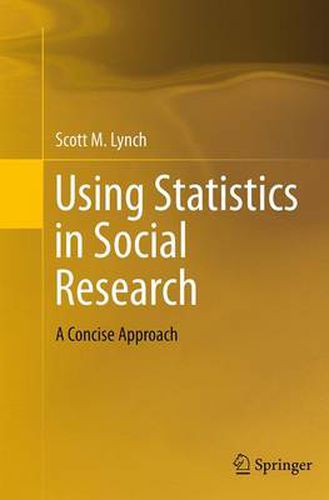Readings Newsletter
Become a Readings Member to make your shopping experience even easier.
Sign in or sign up for free!
You’re not far away from qualifying for FREE standard shipping within Australia
You’ve qualified for FREE standard shipping within Australia
The cart is loading…






This title is printed to order. This book may have been self-published. If so, we cannot guarantee the quality of the content. In the main most books will have gone through the editing process however some may not. We therefore suggest that you be aware of this before ordering this book. If in doubt check either the author or publisher’s details as we are unable to accept any returns unless they are faulty. Please contact us if you have any questions.
This book covers applied statistics for the social sciences with upper-level undergraduate students in mind. The chapters are based on lecture notes from an introductory statistics course the author has taught for a number of years. The book integrates statistics into the research process, with early chapters covering basic philosophical issues underpinning the process of scientific research. These include the concepts of deductive reasoning and the falsifiability of hypotheses, the development of a research question and hypotheses, and the process of data collection and measurement. Probability theory is then covered extensively with a focus on its role in laying the foundation for statistical reasoning and inference. After illustrating the Central Limit Theorem, later chapters address the key, basic statistical methods used in social science research, including various z and t tests and confidence intervals, nonparametric chi square tests, one-way analysis of variance, correlation, simple regression, and multiple regression, with a discussion of the key issues involved in thinking about causal processes. Concepts and topics are illustrated using both real and simulated data. The penultimate chapter presents rules and suggestions for the successful presentation of statistics in tabular and graphic formats, and the final chapter offers suggestions for subsequent reading and study.
$9.00 standard shipping within Australia
FREE standard shipping within Australia for orders over $100.00
Express & International shipping calculated at checkout
This title is printed to order. This book may have been self-published. If so, we cannot guarantee the quality of the content. In the main most books will have gone through the editing process however some may not. We therefore suggest that you be aware of this before ordering this book. If in doubt check either the author or publisher’s details as we are unable to accept any returns unless they are faulty. Please contact us if you have any questions.
This book covers applied statistics for the social sciences with upper-level undergraduate students in mind. The chapters are based on lecture notes from an introductory statistics course the author has taught for a number of years. The book integrates statistics into the research process, with early chapters covering basic philosophical issues underpinning the process of scientific research. These include the concepts of deductive reasoning and the falsifiability of hypotheses, the development of a research question and hypotheses, and the process of data collection and measurement. Probability theory is then covered extensively with a focus on its role in laying the foundation for statistical reasoning and inference. After illustrating the Central Limit Theorem, later chapters address the key, basic statistical methods used in social science research, including various z and t tests and confidence intervals, nonparametric chi square tests, one-way analysis of variance, correlation, simple regression, and multiple regression, with a discussion of the key issues involved in thinking about causal processes. Concepts and topics are illustrated using both real and simulated data. The penultimate chapter presents rules and suggestions for the successful presentation of statistics in tabular and graphic formats, and the final chapter offers suggestions for subsequent reading and study.